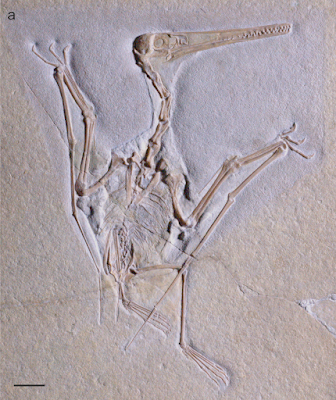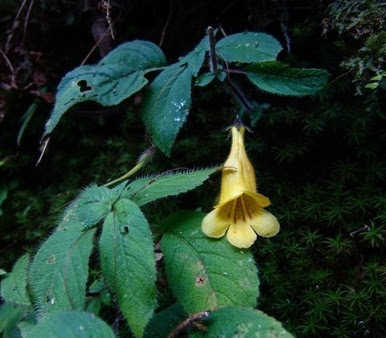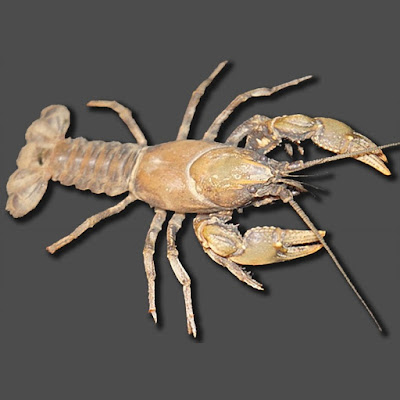[Most Recent Entries] [Calendar View]
Saturday, September 17th, 2016
| Time | Event | ||
| 5:03a | [Paleontology • 2014] Aerodactylus scolopaciceps gen. nov. • Pterodactylus scolopaciceps Meyer, 1860 (Pterosauria, Pterodactyloidea) from the Upper Jurassic of Bavaria, Germany: The Problem of Cryptic Pterosaur Taxa in Early Ontogeny
Abstract The taxonomy of the Late Jurassic pterodactyloid pterosaur Pterodactylus scolopaciceps Meyer, 1860 from the Solnhofen Limestone Formation of Bavaria, Germany is reviewed. Its nomenclatural history is long and complex, having been synonymised with both P. kochi (Wagner, 1837), and P. antiquus (Sömmerring, 1812). The majority of pterosaur species from the Solnhofen Limestone, including P. scolopaciceps are represented by juveniles. Consequently, specimens can appear remarkably similar due to juvenile characteristics detracting from taxonomic differences that are exaggerated in later ontogeny. Previous morphological and morphometric analyses have failed to separate species or even genera due to this problem, and as a result many species have been subsumed into a single taxon. A hypodigm for P. scolopaciceps, comprising of the holotype (BSP AS V 29 a/b) and material Broili referred to the taxon is described. P. scolopaciceps is found to be a valid taxon, but placement within Pterodactylus is inappropriate. Consequently, the new genus Aerodactylus is erected to accommodate it. Aerodactylus can be diagnosed on account of a unique suite of characters including jaws containing 16 teeth per-jaw, per-side, which are more sparsely distributed caudally and terminate rostral to the nasoantorbital fenestra; dorsal surface of the skull is subtly depressed rostral of the cranial table; rostrum very elongate (RI = ~7), terminating in a point; orbits correspondingly low and elongate; elongate cervical vertebrae (approximately three times the length of their width); wing-metacarpal elongate, but still shorter than the ulna and first wing-phalanx; and pteroid approximately 65% of the total length of the ulna, straight and extremely thin (less than one third the width of the ulna). A cladistic analysis demonstrates that Aerodactylus is distinct from Pterodactylus, but close to Cycnorhamphus Seeley, 1870, Ardeadactylus Bennett, 2013a and Aurorazhdarcho Frey, Meyer and Tischlinger, 2011, consequently we erect the inclusive taxon Aurorazhdarchidae for their reception. Systematic Palaeontology PTEROSAURIA Kaup, 1834 MONOFENESTRATA Lü et al., 2010 PTERODACTYLOIDEA Plieninger, 1901 AURORAZHDARCHIDAE fam. nov. AERODACTYLUS gen. nov. Type species: Aerodactylus scolopaciceps (Meyer, 1860). Content: The type species Aerodactylus scolopaciceps gen. nov. is the only species currently contained in Aerodactylus. Diagnosis: As for type and only species. Etymology: Aero = wind (Greek) + dactylus = finger (Greek), a common suffix in pterosaur names. The name derives from the Nintendo Pokémon Aerodactyl, a fantasy creature made up of a combination of different pterosaurian features. It seemed a pertinent name for a genus which has been synonymous with Pterodatylus for so long due to a combination of features. Synonymy: 1850 Pterodactylus longirostris Meyer, p. 199 [48] When Meyer originally described the specimen he referred it to what is now known as Pterodactylus antiquus 1860 Pterodactylus scolopaciceps Meyer, p. 33 1883 Pterodactylus kochi (H. v. Meyer) Zittel p. 25 1901 Pterodactylus scolopaciceps von Meyer; Seeley p. 105 1938 Pterodactylus scolopaciceps H. v. Meyer; Broili p. 146 1970 Pterodactylus scolopaciceps H. v. Meyer, 1850; Wellnhofer p.22 1970 Pterodactylus kochi Wagner, 1837; Wellnhofer p. 22 Holotype: BSP AS V 29 a/b: part and counterpart, with a complete skeleton of a small juvenile. Referred material: BSP 1883 XVI 1 (Fig. 2Bi, ii and 3D) and counterpart MCZ 1505: a complete skeleton of a large individual. BSP 1975 I 221: a complete skeleton on a slab, in left lateral view. BSP 1937 I 18 (Fig. 2A and 3E): a complete specimen with soft tissue, in dorsal and right lateral view. Example of Frey & Martill [20]: a complete specimen with soft tissue in right lateral view. NHMW 1975/1756: part and counterpart, a complete skeleton with soft tissue. Locality and horizon: Solnhofen Limestone, Malm Zeta 2, Solnhofen, Bavaria, Germany. Conclusions: The taxonomy of Pterodactylus is complex due to a suite of plesiomorphic characters that are retained in early ontogeny. Recently, Bennett referred “Pterodactylus longicollum” to the new genus; Ardeadactylus, and synonymised P. kochi with the type and (in our opinion) only species P. antiquus. This synonymy is likely to be erroneous considering that the focussed statistical analyses and a cladistics analysis presented here have demonstrated that “P. kochi” includes at least one other taxon. One such taxon within ‘P. kochi’ is “Pterodactylus scolopaciceps” Meyer 1860 [8]. “Pterodactylus scolopaciceps” is demonstrated to differ from Pterodactylus antiquus in the morphology of its skull and pteroid. Our statistical analysis finds that the two differ in the proportions of the orbit, humerus and pes, and so Aerodactylus gen. nov. is erected for the reception of “P. scolopaciceps”. Remaining specimens of P. kochi are found to have only a few proportions in common with P. antiquus. Notably, the cervical vertebrae of P. kochi are much shorter (nearly half the length when scaled to the same breadth) than those of P. antiquus, and thus we reject Jouve’s [24] and Bennett’s [2] synonymy. Further examination of the remaining specimens contained within P. kochi is required but our analysis suggests that it is generically distinct, and thus validates Diopecephalus Seeley, 1871 [52] (Vidovic and Martill in prep.). Furthermore “Germanodactylus rhamphastinus” is distinct from G. cristatus and requires further taxonomic evaluation. It is probable that “G. rhamphastinus” also belongs in Diopecephalus, as it has a straight dorsal rostrum, teeth beneath the nasoantorbital fenestra and short cervical vertebrae (Vidovic and Martill in prep.). Vidovic, S.U. and Martill, D.M. 2015. Pterodactylus scolopaciceps Meyer, 1860 (Pterosauria, Pterodactyloidea) from the Upper Jurassic of Bavaria, Germany: The Problem of Cryptic Pterosaur Taxa in Early Ontogeny. PLoS ONE. 9(10): e110646. DOI: 10.1371/journal.pone.0110646 | ||
| 5:19a | [Botany • 2012] Briggsia damingshanensis • A New Species (Gesneriaceae) from Guangxi, China
Abstract Briggsia damingshanensis L. Wu & B. Pan is described and illustrated as a new species of Gesneriaceae from Guangxi, China. It is similar to B. dongxingensis, but differs in its densely glandular-pubescent ovary, inconspicuous or absent bracts, pendulous and very slender peduncle, and sparsely pubescent stem and petiole. Wu Lei, Bo Pan, Jin-Cai Yang and Wei-An Xu. 2012. Briggsia damingshanensis (Gesneriaceae), A New Species from Guangxi, China. Annales Botanici Fennici. 49(1-2); 79-82. DOI: 10.5735/085.049.0111 | ||
| 5:47a | [Crustacea • 2016] Cambarus (Jugicambarus) adustus • A New Species of Crayfish from northeastern Kentucky delimited from the Cambarus (J.) aff. dubius species complex A new species of burrowing crayfish, Cambarus (Jugicambarus) adustus, is described from Lewis County in northeastern Kentucky, USA. The new species is most similar morphologically to C. dubius. Cambarus adustus coloration differs from C. dubius by lacking red, orange and blue hues, and instead is brown over the entire body surface. Morphological differences between C. dubius and C. adustus exist in the form I male gonopod, with C. adustus possessing a caudal knob, while C. dubius does not. In addition, the lateral carapace of C. adustus is distinctly tuberculate, whereas in C. dubius the carapace lacks extensive tuberculation. Cambarus (J.) adustus appears to have an extremely small geographic range (~19.5 km2), and as such we suggest its consideration for both state and federal levels of protection. Keywords: Crustacea, Appalachian Mountains, Cambaridae, Cambarus, crayfish, Decapoda, new species Life history. Collections have been made in May, June, August, September, and October. First form males, second form males, and females have been observed in all months sampled. No ovigerous females or young-of year have been observed. Crayfish associates. Cambarus thomai and Cambarus ortmanni are found burrowing in adjacent areas. In streams of the area there is a member of the Orconectes subgenus Procericambarus present. It is not clear if these populations represent an undescribed species or are just a geographic variant of Orconectes raymondi Thoma and Stocker 2009. Relationships. Cambarus adustus is assigned to the subgenus Jugicambarus based on the presence of a cristiform row of tubercles on the mesial margin of the chelae. It appears to be most closely related to C. dubius, C. pauleyi, and other members of the C. aff. dubius complex. It is hypothesized that the species had become established in the preglacial Portsmouth River prior to the onset of the Quaternary. Cambarus adustus displays a caudal knob similar to, but smaller than, Cambarus bouchardi Hobbs 1970. This character state is not thought to reflect a close relationship between the two species. Etymology. The species epithet (adustus = L. brown) is chosen to recognize the overall coloration of this species. The suggested vernacular name is Dusky Mudbug. Conservation status. Cambarus (J.) adustus, new species, is narrowly distributed, with a current extent of occurrence of 19.5 km2 in Lewis County, Kentucky. It is best classified as Endangered following Taylor et al. (2007), Endangered (B2ab(iii), ver. 3-1) using IUCN criteria (IUCN 2001), G1 using NatureServe. It should be listed as S1 by the state of Kentucky, and Endangered by the USFWS. Range and specimens examined. This species has only been found in Lewis County, Kentucky in the Quicks Run, Salt Lick Creek and the eastern edge of Cabin Creek basins. Adjacent areas in Kentucky and Ohio have been searched but no other populations have been found. Taylor and Schuster (2004) did not report C. dubius from Lewis County, KY. Their closest record was a single site reported from Rowan County, KY in the Licking River basin. Roger F. Thoma, James W. Jr. Fetzner, G. Whitney Stocker and Zachary J. Loughman. 2016. Cambarus (Jugicambarus) adustus, A New Species of Crayfish from northeastern Kentucky delimited from the Cambarus (J.) aff. dubius species complex. Zootaxa. 4162(1); 173–187. DOI: 10.11646/zootaxa.4162.1.9 | ||
| 8:25a | [Herpetology • 2016] Hidden Diversity within the Lizard Genus Liolaemus: Genetic vs Morphological Divergence in the L. rothi complex (Squamata: Liolaeminae) Highlights • We study the level of molecular vs. morphological divergence within a lizard species complex • We detected strong genetic divergence, but morphological differences are not that clear • Differential selection pressures was detected implying some level of morphological stasis Abstract Currently, Liolaemus is the second most species-rich reptile genus in the world (257 species), and predictions of its real diversity suggest that it may be the most diverse genus. Originally, Liolaemus species were described as widely distributed and morphologically variable taxa, but extensive sampling in previously unexplored geographic areas, coupled with molecular and more extensive morphological studies, have discovered an unexpectedly high number of previously undetected species. Here, we study the level of molecular vs. morphological divergence within the L. rothi complex, combining a total of 14 loci (2 mitochondrial and 12 nuclear loci) for 97 individuals, as well as morphological data (nine morphometric and 15 color pattern variables), that represent all six described species of the L. rothi complex, plus two candidate species. We use the multi-coalescent species delimitation program iBPP and resolve strong differences in molecular divergence; and each species is inferred as an independent lineage supported by high posterior probabilities. However, morphological differences are not that clear, and our modeling of morphological characters suggests differential selection pressures implying some level of morphological stasis. We discuss the role of natural selection on phenotypic traits, which may be an important factor in “hiding” the real diversity of the genus. Keywords: natural selection; species tree; iBPP; divergence times; Patagonia Melisa Olave, Luciano J. Avila, Jack W. Sites Jr and Mariana Morando. 2016. Hidden Diversity within the Lizard Genus Liolaemus: Genetic vs Morphological Divergence in the L. rothi complex (Squamata: Liolaeminae). Molecular Phylogenetics and Evolution. DOI: 10.1016/j.ympev.2016.09.009 |
| << Previous Day |
2016/09/17 [Calendar] |
Next Day >> |








